
Полная версия
Novoslovnica. Guide for a Slavic constructed language
The last topic that we will speak of pertaining to vowels, is the firmness and the softness of the vowels. Scientists argue about what is primary in making sound soft or hard – consonants or vowels. Novoslovnica claim vowels are softer or hard primarily, although consonants itself also can be either soft or hard.
There are vowels that tend to make their surrounding soft and there are vowels that tend to make their surrounding hard. As you already know, there are two nasal vowels – one hard (O-nasality) and one soft (E-nasality). However, there are other pairs of hard / soft vowels among ordinary ones. Look at table 1.4 for more information.
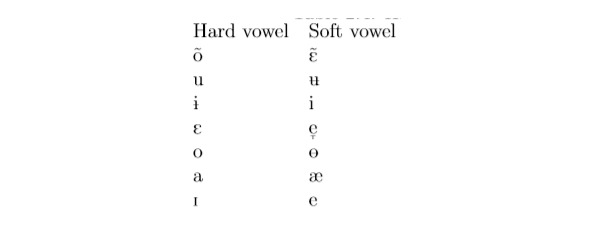
Hard and soft vowels
Examples:
Dodatek (addition) [do`datek]
Smërtj (death) [sme̞rc]
There is only one vowel that has no pair in softness / hardness. It is ə. This vowel is named the «schwa» sound and it can be described as the most «middle» sound among vowels. To pronounce it you should relax your oral cavity and pronounce a sound with weakened muscles. This is the «schwa» sound.
Consonants
In this paragraph about consonants, I would like to begin with the definition of a consonant.
Consonant (C) – a sound that is articulated with complete or particular closure of the vocal tract.
Likewise vowels, consonants have three characteristics that determine their position in your articulation. These three parameters are:
• Place, where the consonant is pronounced in the mouth
• Manner, how the consonant is pronounced
• Sonority, whether you use your vocal cords or not
Place of the consonant can be quite different. Here are possible types: Bilabial, labiodental, dental, alveolar, postalveolar, palato-alveolar, retroflex, alveolo-palatal, palatal, labio-velar, velar. There are more types, but they do not exist in Novoslovnica.
Manner is the way how you pronounce the sound. There are also different manners, that are used in Novoslovnica. They are: nasal, stop, affricate (sibilant), sibilant fricative, non-sibilant fricative, approximant, trill, lateral approximant.
Sonority is the boolean attribute of pronunciation. You can either use your voice with the sound you pronounce or not. Notice that vowels cannot be pronounced without the use of your voice.
Combining these three parameters, we get the unique consonant that we want to pronounce. We cannot draw a 3-dimensional table, because there are three parameters on input, so we will combine information into 2-dimensional space as in paragraph about vowels. So, look at the figure and see the different consonants that are used in Novoslovnica.

Consonant sounds in Novoslovnica
Different colors of the cells show the sonority of the consonant. Yellow color shows that the sound is voiced, while green ones are for voiceless sounds.
Blue cells in the table show that sounds in it can be used both in voiced and voiceless forms as allophones.
Novoslovnica has 51 consonants, 21 of them are voiceless and 30 are voiced.
However, not all of these consonants are language phonemes. So, let’s talk about the allophones among these sounds.
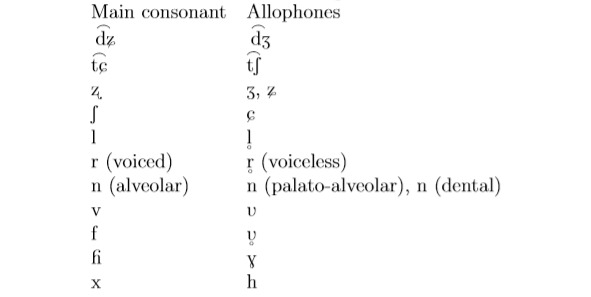
Consonant allophones in Novoslovnica
Exception: The sound θ has no pair, because its pair ð has never been used in Slavic languages.
Likewise vowels, consonants can be compared with each other in terms of softness / hardness. The common rule is that every consonant has its soft or hard partner.
Exception: Two sounds are exceptions to this rule.
• Also nasal velar consonant ŋ has no soft pair.
• And vice versa, the sound j is soft and has no hard pair.
Remember this exception, let’s look at the table 1.7 to get acquainted with pairs of consonants.
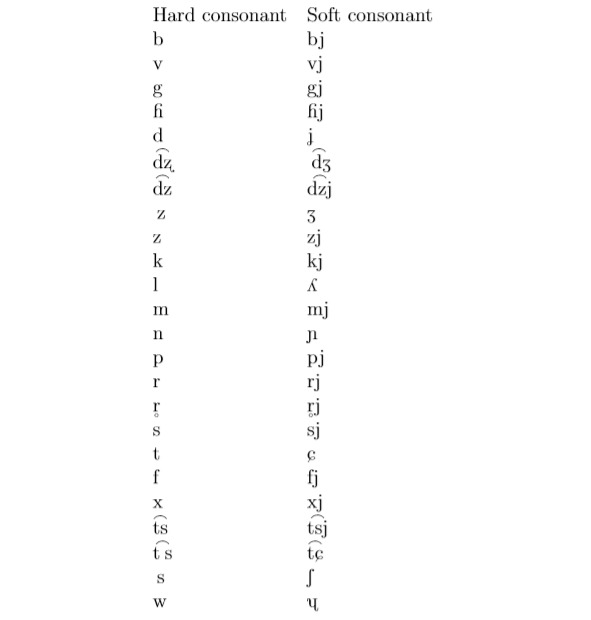
Hard and soft consonant allophones
As you see, every consonant from table has its own soft pair. The soft consonant is usually written as a hard consonant with the sound j attached, but some of them are provided as unique sounds by IPA, because in some languages they can be phonemes.8
Extra sounds
By reading this paragraph you should be aware about Novoslovnica phonemes. At the beginning we will speak about two main features of the language: reproduction and alternation.
Reproduction (extra sounds) – is a process of adding a new sound (consonant or vowel) in the word.
Alternation – is a process of changing some sound (consonant or vowel) or sounds to another one (s).
What are the purposes of alternation and reproduction? These terms both obtain the single aim – to make our speech comfortable for ourselves.
Every language has its own comfortable combinations of sounds and avoided ones. Some languages alternate these uncomfortable character rows into another ones that are comfortable for language speaker in writing, some languages keep writing etymological and alternate the pronunciation of the uncomfortable words. Take into account the fact, that the concept of comfort is relative, that means two different languages (which are spoken by different nations) have different modes of comfort.
Example: you can look at and compare German and Dutch languages. They are very close, but they have different ways for comfortable pronunciation. The word «book» in German sounds like «Buch», but in Holland it sounds like «boek». Thus, you see that these words are familiar, but their pronunciation differs a lot.
Moreover, even one language spoken in different areas can differ greatly in the areas it is spoken.
Example: American and British English. You know that it is still the same language, but pronunciation differs so greatly that American person can not always understand in ordinary speech (quick temp of speaking) what the British person have said.
This is the example how the same language differs in areas it is spoken. Furthermore, these areas may not be far away from each other. You can find information about different patois and even dialects in very small regions.9
Novoslovnica as a panslavic language absorbs different conceptions of the comfort term of Slavic languages.
When reproduction is used, we add a new sound before the word we want to say. It can be whether a vowel or a consonant, depending on the previous letter in the word.
When should we reproduce a sound? To deal with this problem, you should know a thesis, which is widely used in Novoslovnica.
Rule n. 1: After consonant there should be placed a vowel. And after a vowel there should be placed a consonant.
This rule will help you in speaking and writing, when you construct your words with the reproduction.
There is a limited row of sounds that are allowed to participate in reproduction. In the table 2.1 you can see all of them.
Examples:
osem (eight) [`osɛm] – vosem [`vosɛm]
gra (game) [ɦra]} – ïgra [i`ɦra]
So now the only problem is to know about how should we reproduce these sounds.
Reproduction of consonants can be found in different parts of the word. There are three places, where reproduction can appear – the beginning of the word, middle part of the word and the ending of the word.
When we speak about the beginning of the word, we should take into account what sound is at the end of the previous word. Due to rule 2 we should try to keep the «consonant-vowel» sequence inside our sentence. That’s why, we should do actions from the list below:
If the previous word ends with the vowel and temporal word begins also with the vowel we should add in the beginning of the word a consonant V or J. The choice of what letter to add depends on the vowel which is in the temporal word.
• We should choose J for soft vowels
• We should choose V for hard ones.
• If there is one consonant and one vowel in the set of the first letter from the temporal word and the last letter from the previous word, we should not add nothing.
Speaking about word endings, thesis 1 is also very important. We should add a letter B to the end of the word, if the next word begins with the vowel and temporal word ends with the vowel too.
As you see these two principles are practically equal, because wherever we add a consonant, the result will be the same. So the question is, when we should add to the end of the word a consonant and when we should add it to the beginning of the word. In practice, almost always we use the first case, when we add a consonant to the beginning of the word. The second case is used in prepositional constructions with such a word as «O» (about) (Look: «O» – «Ob»). In other cases try to use letters V and J for reproduction.
The third case of consonant reproduction is to reproduce it in the middle of the word. It is used, when there is a row of vowels in the word and it is difficult to pronounce them all together. Then you can divide them by the consonant J, which is put between the neighbor vowels. Don’t confuse it with the case, when with the addition of a vowel letter Ǐ transforms to letter J (see the next paragraph for it) and you receive to vowels divided by this consonant two. Look at the examples of consonant reproduction in the middle of the word.
Examples:
ïdiot (idiot) [`idɪot] – ïdijot [`idɪʝot]
The same situation is about vowel reconstruction. You can find it in the beginning, in the middle and in the end of the word, but it is a bit simpler than a previous one. Vowel reproduction appears when there is a rather large amount of consonants in one place of the sentence. This means that you can find a row of consonants in the word or a consonant conjunction in the end of one word and in the beginning of the next one. In any case, you should concern here about whether it is comfortable for you to pronounce these combinations of sounds.
In the beginning of the word we add a vowel Ï and there are no other cases. Very simple.
Examples:
gra (game) [ɦra]} – ïgra [i`ɦra]
In the middle or in the end of the word we add a vowel O. This case is used with prepositions and prefixes («K» – «Ko», «S» – «So» etc).
Examples:
k domu (to home) [k `domu] – ko dvoru [ko `dvoru]
Alternation
Alternation is a very important feature of Slavic languages. All of them provide some cases, when one letter changes to another one (s) and controversially. The cause is the fact that some sound combinations are difficult to be spoken or not comfortable for that. For example, Slavs can say «napisati» (to write), but «napišut» (they (will) write). The variant «napisut» is not comfortable to pronounce and, moreover, it is not understandable. What are you speaking – «to write» with hardened T or «they write» with depalatalized S. So you can see, that these rules are often experimental and cannot be explained in a common way.
Alternation can be found mostly in conjugation or declension of the word, because the process is in changing uncomfortable forms to better ones while changing the base and endings of the word.
In this paragraph we will speak about different examples of vowel and consonant palatalization. Let us begin with the consonants.
Alternation S//Š
This alteration appears in words with the letter S before a vowel A. The basic sound is S, which changes to Š before vowels I, E and in some cases before A in conjugation. Let’s look at examples to understand how it works.
Examples:
Pisati (write) [`pɪsatɪ] – piši [pɪ`ʂɪ]
Vysok (tall) [vɨ`sok] – povyšati [po`vɨʂatɪ] (to increase)
Alternation K//Č
This alteration appears in words with the letter K before a vowel A without a following vowel. The basic sound is K, which changes to Č before vowels Ě, N. Let us look at examples to understand how it works.
Examples:
Věk [vek] – věčen [`vet̠ʃɛn]}
Vëlïk [`ve̞lik] (Big) – vëlïčina [`ve̞lit̠ʃɪna] (Measure)
Alternation C//Č
This alteration appears in words with the letter C before a vowel A. The basic sound is C, which changes to Č before vowels I, E. Let us look at examples.
Examples:
Ptica (bird) [`ptɪtsa] – ptičen (birdish) [`ptɪt̠ʃɛn]
Věnec [`venɛts] (Crown) – Věnčati [`vent̠ʃatɪ] (To crown)
Alternation D//Đ
This one appears in words with the letter D before a vowel I. This consonant changes to Đ before vowels A, E and U. Let us look at the examples.
Examples:
Voditi (drive) [`vodɪtɪ] – vođati [`voɖʐatɪ]
Roditi [`rodɪtɪ] (bare) – rođati [`roɖʐatɪ]
Alternation Ǐ//J
This alternation is very simple. We write Ǐ before a consonant or in the end of the word and we write J before a vowel. The exception is the case, when we write Ǐ in the end of the word, but the first letter of the next word is a vowel – then we pronounce J, but write Ǐ.
Examples:
Môǐ (my) [mʊj] – moja [`moʝa]
However, not only consonants can change in the word when we conjugate or decline it. There are some alterations of vowels too.
Alternation Ò//-
This alternation appears in some old roots (see next paragraph).
Examples:
Tòk (stick) [tək] – tkati [`tkatɪ] (to weave)
Alternation E//-
This alternation is similar to the previous ones, but exist in word suffixes.
Examples:
Krasen (Nice) [`krasɛn] – krasna [`krasna]
Alternation Ę//En
This alternation is rather narrow, because it is used in the case of declension nouns of type 3 (look paragraph about noun declension), when the nasal vowel [ɛ̃] alternates to non-nasal pair of vowel «E» and consonant «N» (non-nasal!). To understand it look at the example
Examples:
Vremę (time) [`vrɛmjɛ̃] – vremenï [`vrɛmɛɲi]
Plemę (tribe) [`plEmjɛ̃] – plemenï [`plɛmɛɲi]
In the conclusion of this paragraph it should be mentioned that alterations are very important in Slavic languages and Novoslovnica as well. You can use reproduction in your speech as a recommended feature, while alterations are complimentary in this language. As it was noted before, we cannot ignore anything that can bring a misunderstanding in our speech.
Runaway vowels
Looking back in the Slavic language history we can find out that there were roots with two strange for an ordinary person vowels – «Ò» and «J». First one was named «Yer» and denotes a hard mid central vowel (Shwa). The second one was named «Yerj» (with soft R) and denotes a soft mid central vowel. Now the second one is lost and we use only shwa sound in the letter «Yer». However, the words are still and we need to pronounce them in some way. Novoslovnica uses the soft «E» sound to represent roots with old soft shwa sound.
Main feature of these sounds was to fall out from the root, when a vowel appears afterwards. That’s why there are many words with two consonants consecutively – there is an imaginary shwa sound between them that has been fallen out from the root.
Nevertheless, despite falling out of «Yer», soft «E» in this places does not fall out. So, in the previous paragraph you could see that there are two alternations O//– and O//Ë, that are handled in the similar positions. So the answer on the question, why in the first case there is no sound and in the second there is a soft E is the fact, that words satisfying the first case comprise old hard shwa sound and remain comprise old soft shwa sound, that has transformed into soft E.
The fact should be mentioned that nowadays the letter Ò exists only in roots of the words. In suffixes the letter E is used for this sound and in the prefixes the letter O is used.
Look at the examples:
– pod
– ek
– pòk
However, you should remember that speaking the words with these letters we should pronounce them just as they are written – Ò as shwa, E as E, O as O. You should not reduce all the sounds to shwa.
Accent
Accent is a very difficult topic in most languages, because it is not permanent. There are some exceptions i.e. Czech and French, but in most cases we cannot say where accent will be put in the word without studying definite language. This causes problems for beginners.
Novoslovnica has a dynamic accent, but it has been formalized. There is a rule, that determines the place you should put the accent.
Rule n. 2: The accent should be put on the first syllable of the word root.
This rule covers about 80% of the words in the lexicon. You know the well-known 80/20 rule, or Pareto principle. It is something alike with the accent. Remained 20 per cent of the words we should cover by introducing extra-rule cases. Accepting these cases, you will be able to cover more than 99 per cent of Novoslovnica word amount.
These cases were created in attempt to unify the accents in different Slavic languages. Surely the Slavic languages have greatly changed since then, as they were one language. Therefore, accents in different Slavic languages often differ. Nevertheless, Novoslovnica tries to obliterate differences between them, producing accent patterns that could be comfortable to pronounce and to hear for all Slavs.
Below you can see the list of all these cases, that you should remember while speaking Novoslovnica.
Accent shifting cases:
– Accented endings (Nouns)
• -a (Dual, Nominative)
• -y (Singular, Genitive/Partitive)
• -ami (Plural, Instrumentative)
• -ama (Dual, Dative)
• -am (Plural, Dative)
– Accented endings (Verbs)
• -i Imperative (see paragraph about verb moods)
– Accented suffixes
• -ova- (Verb)
• -ôva- (Verb)
• -ava- (Verb)
• -óv- (Adjective)
• -ak- (Noun)
• -ok- (Noun)
– verb suffixes in Present Concrete Tense (see paragraph about verb tenses)
– Accent shift in the root
• If the word is a borrowed one, then the accent is put on the place it is in the original word.
• If the root loses its vowel, the accents moves one vowel to the left (if it is possible)
• Words that have more than one root (complex words) have their accent on the first syllable of the main word’s root. (see paragraph about complex words for what root is main)
• Adverbs or other parts of speech, formed with the prepositional construction, have their accents on the first syllable of the main word (see paragraph about collocations)
These rules are enough for you to speak Novoslovnica properly with a few efforts for it.
Accent integrity
There is also one term, that you should to know when you use Novoslovnica or any other Slavic language in your speech. This term is called accent integrity. Firstly I will introduce a term of a dependency structure:
Dependency structure is a prepositional construction or a collocation.
That means, that this abstract term expands the term of collocation by involving prepositional into itself.
Accent integrity is a property of a dependency structure to unify elements of this structure with only one accent on the main word.
What does this definition say? If we have a collocation\index {collocation} or a prepositional construction and we want to pronounce it, we should pronounce dependent words without any accent and put an accent on the first word of the structure. Look at the examples.
Examples:
Pod něbom [`pod nebom] – Under the sky
Surely, you should remember that this might be applied only for brief structures, most often with one dependent word (or a preposition) of one or two syllables. If we have a long dependent word or there are too many dependent words in the construction, we pronounce them with a proper accent on each of the structure elements.
Examples:
Pod sïnïm něbom [pəd `sinim `nebom] – Under the blue sky
Orthography
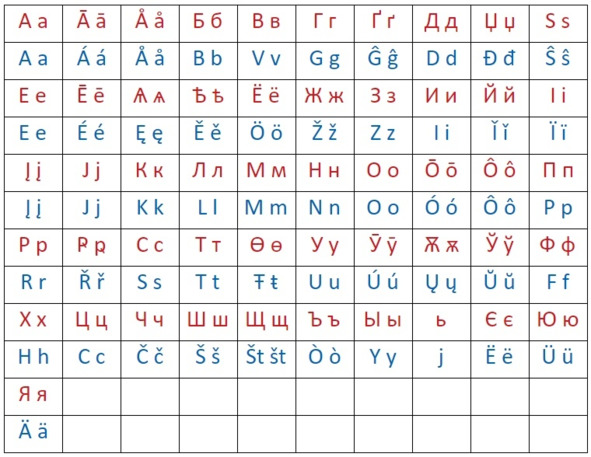
Alphabet of Novoslovnica
Alphabet
Let’s summarize what we have known about Novoslovnica phonology. Afterwards we will get the list of phonemes and allophones and their connections with Novoslovnica letters in the alphabet.
We have learned that Novoslovnica has 51 consonant sounds and 22 vowels. 13 consonants and 4 vowels are allophones among them. Hence, the amount of phonemes is (51—13) + (22 – 4) = 56 phonemes.
You should know that in Novoslovnica, soft and hard consonants do not differ in writing. That is because of the fact that by the combination of «consonant + vowel» we can always determinedly get what the consonant is like – hard or soft. With this information, the amount of letters needed is reduced to 49.10
Nevertheless, let’s now look at the table with the alphabet list and see how Novoslovnica is written.
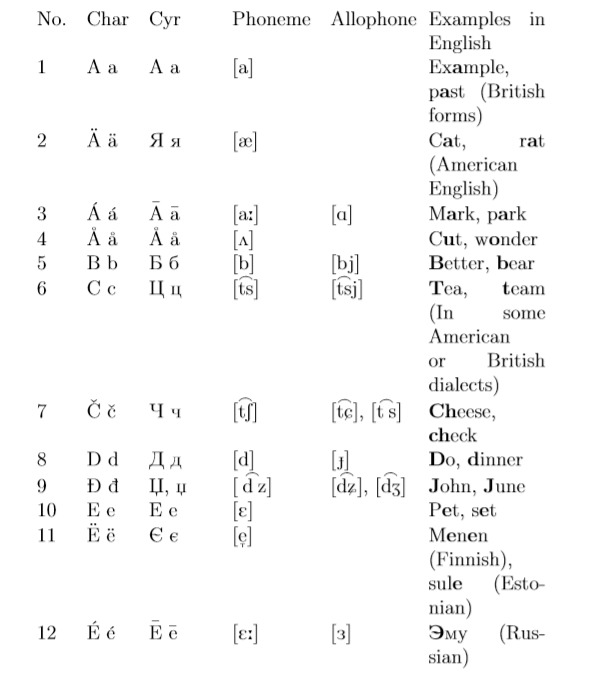
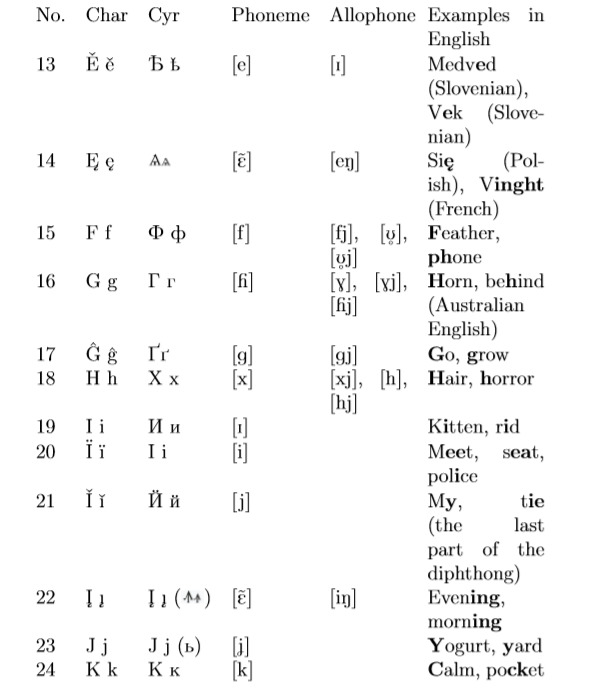
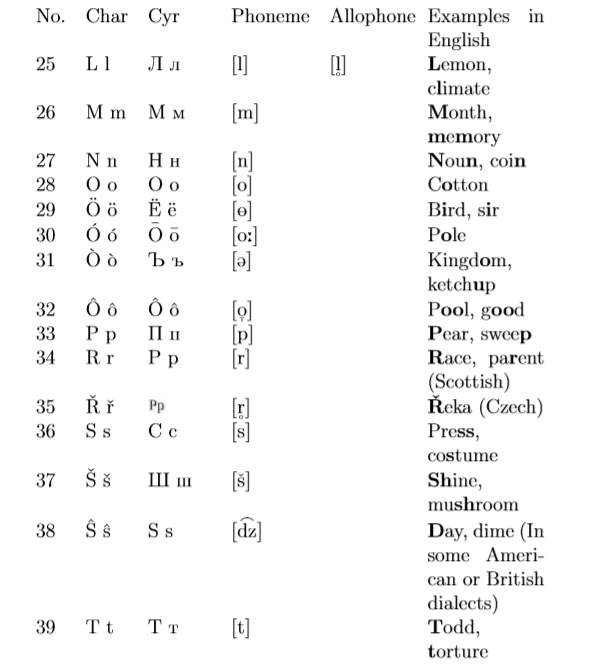
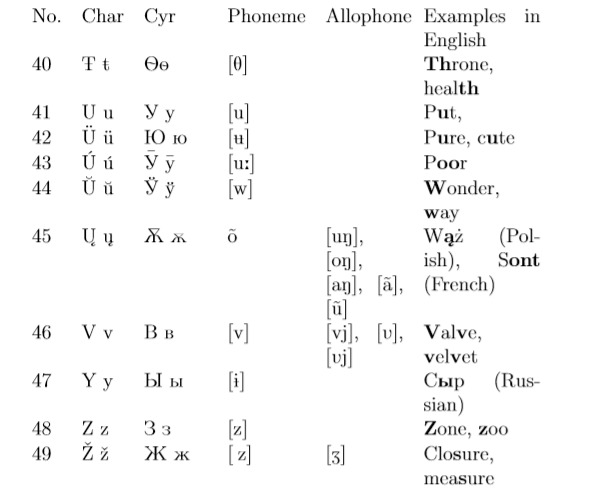
Alphabet of Novoslovnica
Note, that the Cyrillic letters Щ, Ψ, Ќ, Ї in earlier versions of Novoslovnica have been replaced by Шт (Št), Пс (Ps), Кс (Ks) and Ји (Jі).11
Pronunciation
Novoslovnica is a phonetic language, that’s why Novoslovnica has an important rule, which you have to apply to speaking in Novoslovnica.
Rule n. 3: All words are pronounced as they are written.
This rule means that you cannot reduce sounds when speak in Novoslovnica. It is a very important thing because you can make mistakes if you speak improperly. There are some exceptions but they all will be mentioned in this guidebook.
When you pronounce a word you are not restricted to use only main sounds – if it’s more comfortable, you can pronounce allophones with the same level of softness and sonority with the main sound of the letter. Let’s look at the examples below to understand what we can choose in speaking and what we cannot.
Examples:
– okolo [o`kolo] – around
– čujstvo [`t̠ʃujstvo] – feeling
However, you are restricted in what consonant sounds to use from the allophone list. You can see the next rule which will help you to speak.
Rule n. 4: You cannot mess soft and hard consonants when you pronounce a word.
This prohibit you to make hard consonants when you need a soft one, or to use a soft one when you need a hard one. Here you can see a table, where it is shown which sound you must pronounce in different combinations of letters.
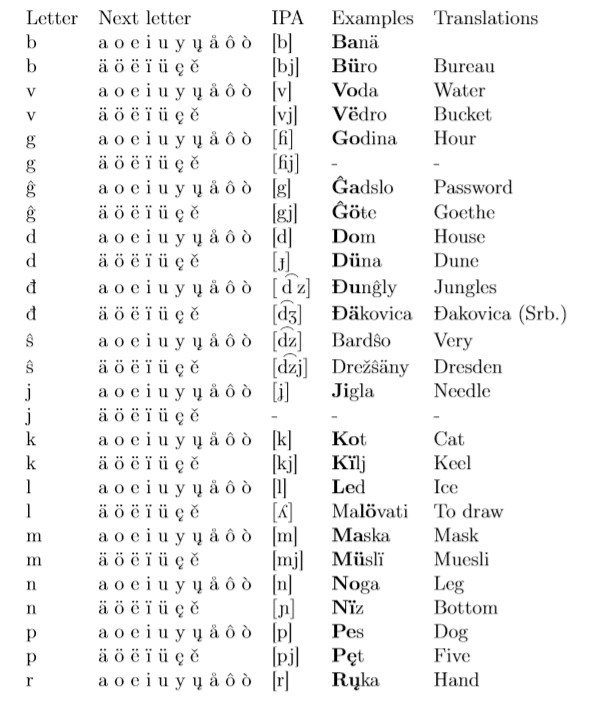
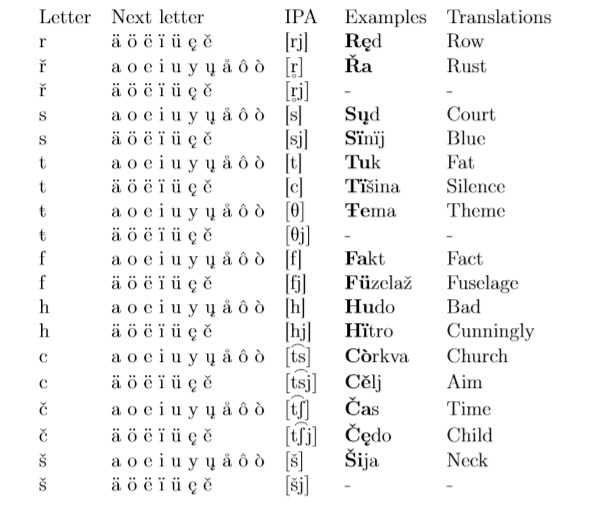
Soft and hard vowel-consonant pairs

